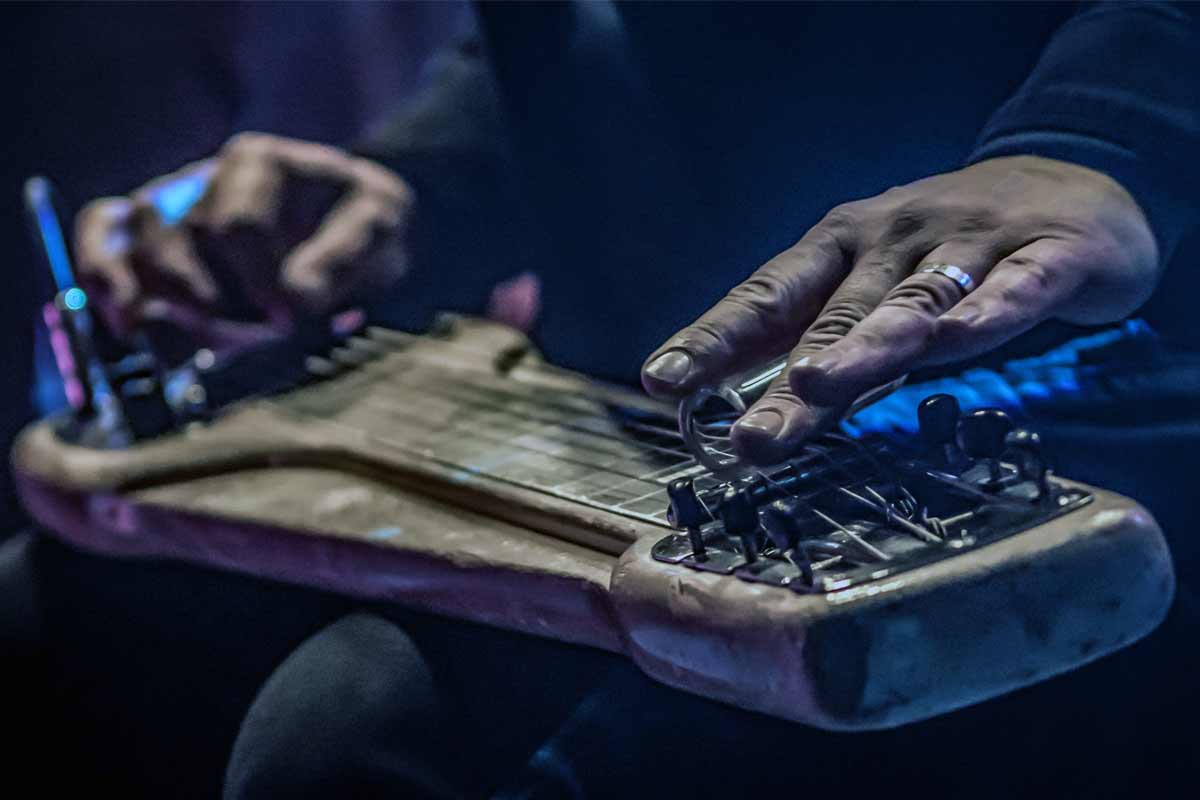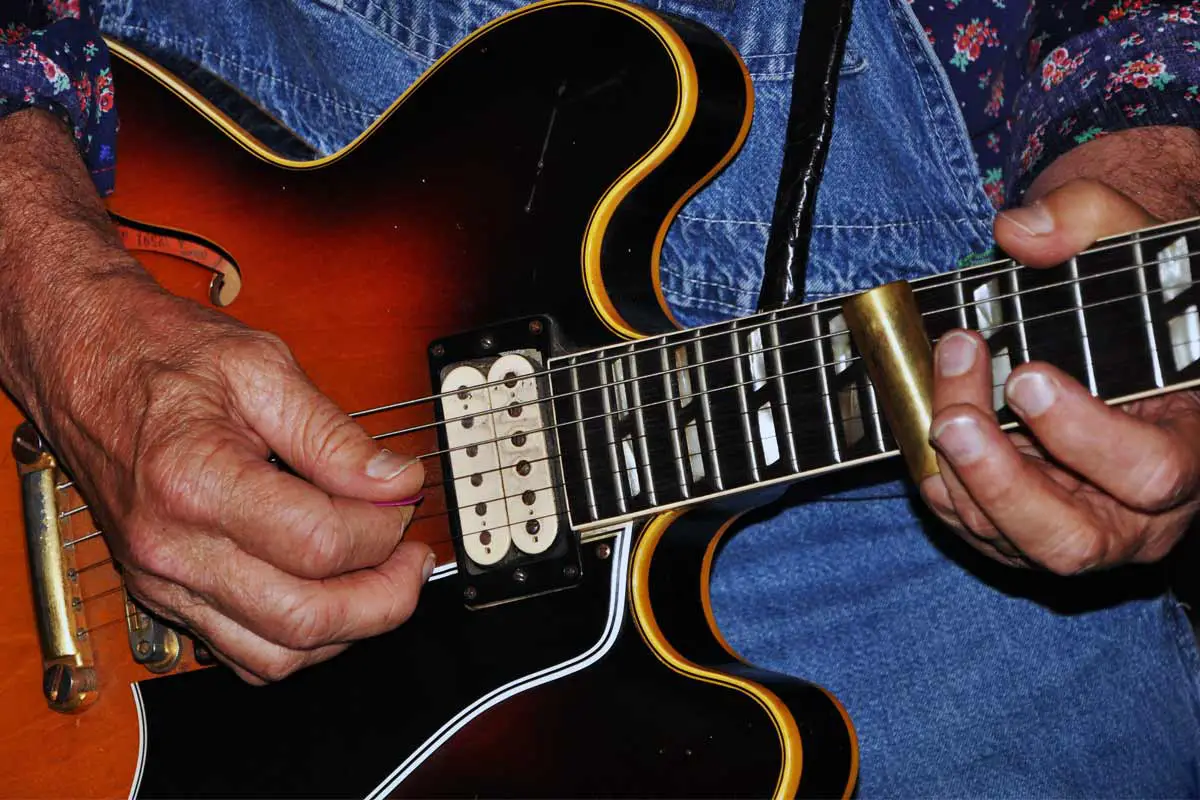Are you looking to unlock new musical possibilities on your guitar? Tuning a guitar to Open D might be just the key you need.
Open D guitar tuning is an alternate tuning where the guitar is tuned to a D major chord, resulting in a rich and resonant sound. This open tuning, is popular among guitarists who want to explore a different tonal palette, experiment with unique chord voicings, and explore melodic possibilities.
Open D tuning is commonly used in genres like folk, blues, and especially slide guitar, allowing players to achieve a rich, full sound with minimal effort.
By utilizing the open guitar strings as part of chord shapes, you can easily create lush, expansive chords and add depth to your playing. Here’s all you need to know about them!

Open D Tuning Basics
In terms of music theory, the main difference between Standard E tuning (EADGBE) and Open D tuning (DADF#AD) on the guitar lies in the intervals between the strings and how they impact chord voicings, scales, and transposing. Here are some key differences:
Intervals: In Standard E tuning, the intervals between the strings are mostly fourths except for the interval between the third (G) and second (B) strings, which is a major third.
In Open D tuning, the intervals are different. The interval between the sixth (D) and fifth (A) strings remains a fourth, but the interval between the fifth (A) and fourth (D) strings is a major third. The rest of the intervals are fourths.
Chord Voicings: The altered intervals in Open D guitar tuning result in unique chord voicings compared to Standard E tuning. Open chords in Open D tuning often utilize open strings, which can produce rich and resonant sounds with more strings being played simultaneously.
However, chord shapes need to be adapted or relearned to accommodate the new tuning, resulting in different voicings and harmonic textures.
Transposition: Transposing chord progressions or melodies between Standard E tuning and Open D tuning requires adjusting the positions and shapes of chords. This is because the root note positions and relationships shift due to the altered string intervals.
It’s important to understand the new relationships between notes and chords in Open D tuning when transposing or playing music written for Standard E tuning.
Melodic and Harmonic Possibilities: The altered intervals in Open D tuning can inspire different melodic and harmonic ideas.
The open guitar strings can be used as drones or pedal tones, creating a sustained and atmospheric backdrop for melodies and chords. This can influence the creation of melodies major chords, arpeggios, and chord progressions, offering unique tonal colors and textures.
Slide Guitar Techniques: Open D tuning is commonly used in slide guitar playing, where a slide is used to glide along the strings. The altered intervals and open string configuration lend themselves well to slide guitar techniques, allowing for expressive slides, bends, and vibrato.
How To: Open D Guitar Tuning
To tune your guitar to Open D tuning, you can follow these steps:
Start with a properly tuned guitar in standard guitar tuning (EADGBE).
Begin by loosening the low E string (thickest string) tuning peg until it reaches the desired D pitch. You can use a tuner or compare the pitch to a reference note, such as a piano or another tuned instrument.
Once the low E string is tuned down to D, you can move on to the A string. Play the newly tuned D string (4th string) at the 7th fret and adjust the A string (5th string) tuning peg until it matches the pitch.
Next, tune the D string (4th string) by playing it open and matching the pitch with the newly tuned A string (5th string).
For the G string (3rd string), play the D string (4th string) at the 7th fret and adjust the G string until it matches the pitch.
Tune the B string (2nd string) by playing the G string (3rd string) open and matching the pitch.
Finally, tune the high E string (1st string) by playing the B string (2nd string) open and matching the pitch.
After completing these steps, your guitar should be tuned to Open D tuning (DADF#AD). It’s always a good idea to double-check the tuning using a guitar tuner, or reference notes to ensure accuracy. Remember to be gentle when adjusting the tension of the strings to avoid breaking them, and enjoy exploring the unique sounds and new possibilities!
Essential Guitar Chord Shapes
Here’s a few chord charts to check out including open D chords in order to get a feel for this alternate tuning.
Many of these use open strings which sound great without putting in a huge amount of effort.
Try the different chords and see which ones you like or try to fit them into your own chord progression.
Related: How to read chord charts
D Major Chord
You can always just strum all of the open strings to get a D major chord but here’s something a bit different that doubles up on the notes.

A Major Chord
The thing about this tuning is that if you bar any fret across, you get a major chord which is why it’s so great for slide guitar.

B Minor Chord

Dsus4 Chord

D9 Chord

Songs That Use Open D Guitar Tuning
“Little Martha” by The Allman Brothers Band
“Big Love” by Fleetwood Mac
“When the Levee Breaks” by Led Zeppelin
“Friend of the Devil” by Grateful Dead
“Romeo and Juliet” by Dire Straits
“Slide” by Goo Goo Dolls
Other Alternate Tunings To Try
Here’s a few different tuning options we’ve also covered:

Frequently Asked Questions
What are open strings?
Open guitar strings are the strings that are played without any fretting. They are called “open” because they are played in their natural state, without any finger pressing down on a fret.
When strummed or plucked, these open strings produce specific pitches corresponding to their respective notes. For example, E, A, D, G, B, E for Standard E guitar tuning, or in the case of Open D guitar tuning, it’s D, A, D, F#, A, D.
Is Open D the same as Drop D tuning?
No, Open D tuning and Drop D tuning are not the same.
Open D tuning refers to a specific alternate tuning where the guitar is tuned to a D major chord, typically with the strings tuned to D-A-D-F#-A-D from low to high. In Open D tuning, all the strings are tuned to specific pitches that form a D Chord(Major) when strummed open.
On the other hand, Drop D tuning is a variation of Standard E tuning where only the lowest-pitched string, typically the low E string, is tuned down one whole step to D. The rest of the strings remain in standard guitar tuning (E-A-D-G-B-E).
While both Open D and Drop D tuning involve tuning the guitar to a D note, they have different approaches and result in different overall tunings. Open D tuning provides a different set of chord shapes and harmonic possibilities, whereas Drop D tuning mainly affects the lowest string to enable playing fast power chords and adding extra depth to the low end.
What is D Standard tuning?
D Standard guitar tuning, also known as Whole Step Down tuning, is an alternate guitar tuning where all six strings are tuned down a whole step (two frets) from Standard E tuning. In D Standard, the string notes from the thickest (lowest-pitched) to the thinnest (highest-pitched) strings are as follows:
D, G, C, F, A, D
By tuning down all the strings uniformly, D Standard results in a lower overall pitch compared to Standard E tuning but everything is essentially played the same way between the two.
This tuning is popular in various genres, including rock, metal, and blues, as it provides a heavier and fuller sound, allowing for added depth to guitar riffs.
Should I tune D standard or Drop D?
The choice between tuning to D Standard or Drop D depends on your specific musical preferences and the requirements of the music you’re playing. Here are some considerations to help you decide:
D Standard Tuning:
D Standard provides a lower overall pitch compared to Standard E tuning, resulting in a heavier & fuller sound.
D Standard tuning is commonly used in various genres, including rock, metal, and blues or whenever a thick tone is desired.
D standard is played exactly the same as E standard guitar tuning.
Drop D Tuning:
Drop D tuning is a variation of standard tuning where only the lowest string is tuned down to D, while the other strings remain in standard tuning.
Drop D tuning is often favored by guitarists looking for a heavier sound, as it allows for easy 1-finger power chord formations and facilitates playing low, heavy riffs at a faster pace.
It is commonly used in hard rock & heavy metal genres.
Ultimately, the choice between D Standard and Drop D tuning depends on the style of music you play and the specific sound you want to achieve. Try experimenting with both alternate tunings and see which one better suits your musical preferences and the songs you are playing.
What is the most popular drop tuning?
The most popular drop tuning on guitar is Drop D tuning. In Drop D tuning, the lowest string (typically the low E string) is tuned down one whole step to D, while the rest of the strings remain in standard E tuning. This tuning is widely used in hard rock & metal genres.
Drop D tuning is popular because it offers several advantages, such as:
Fast Power Chords: The tuning allows for easy barre chord formations with one finger barring across the lowest three strings, resulting in a heavy and powerful sound.
Crushing Low-End Riffs: The lowered pitch of the lowest string enables guitarists to play booming, heavy riffs with ease, providing a driving and aggressive tone.
One-Finger Bass Notes: With the sixth string tuned to D, guitarists can use their thumb to play bass notes on the lowest string while strumming or picking chords on the higher strings.
